A Moroccan Love Story
… The Majorelle Garden in Marrakech, Morocco, in the Guéliz district, is a lush and intimate Botanical Garden. Created by Jacques Majorelle, French adventurer and orientalist painter who settled in Morocco in 1917, it is today one of the most famous gardens in the world.
Discover the history of this legendary and timeless Garden, which almost disappeared.
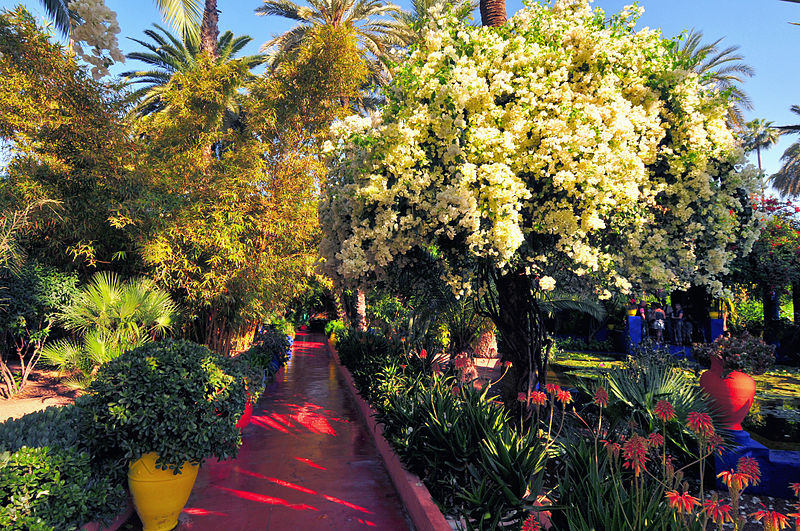
Jardin majorelle a marrakech bougainvillers nenuphar
1/ The Creation of the Majorelle Garden in Marrakech
In convalescence, and following the invitation of General Lyautey, friend of his father, Jacques Majorelle visited Marrakech for the first time in October 1917 then under French protectorate. Fallen in love with North Africa, he settled some time later definitively in the medina of Marrakech.
In 1923, he acquired a 1.6 hectare plot north west of the medina, on the edge of the palm grove. The ground is partly planted with poplars, “saf saf” in Arabic, which will give the name to the Moorish villa that he will have built “Villa bou saf saf”. He also built a Berber building flanked by a tower (“borj”) as paint and craft workshops.
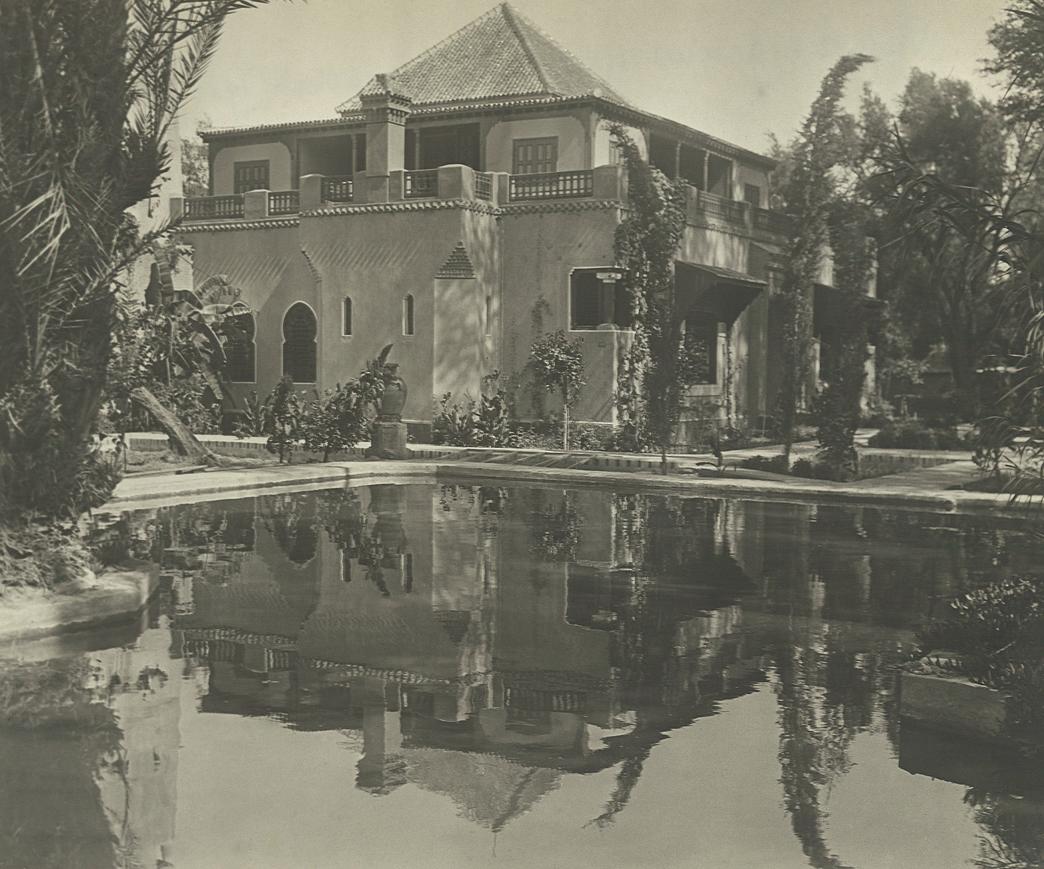
Jacques Majorelle YSL Villa Bou Saf Saf Oasis marrakech
In 1928, Jacques Majorelle, passionate about Botany, acquired 2 new plots adjacent to his property, bringing the total area of the land to 4 hectares in order to create a Garden. 2 years later, in 1931, the architect Paul Sinoir built a cubist villa on the new land, and added a long narrow basin of shallow depth. The ground floor of the villa serves as a painting studio and the 1st floor studio.
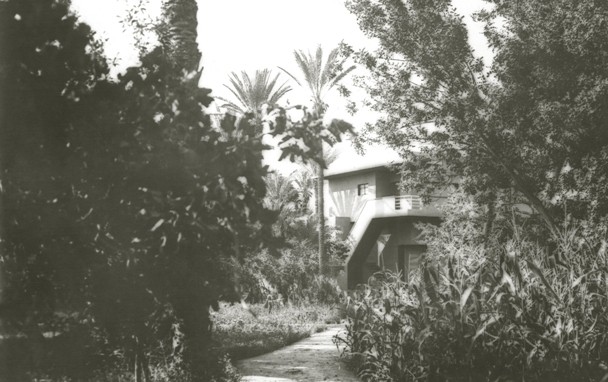
Latelier-Jardin Majorelle-dessiné-par-Paul-Sinoir-circa-1931-
It was in 1933 that Jacques Majorelle added balconies and an arabic pergola to the cubist villa and laid out his lush garden with plants collected from all over the world: coconut trees, cacti, banana trees, bougainvilleas, water lilies, yuccas, jasmines, water lilies, palm trees, bamboos.
2/ The Majorelle Blue
Very quickly, in 1937, Jacques Majorelle painted the cubist villa of an intense and soft Bleu Outremer, inspired by the waters of Lake Tasgah, in the Moroccan atlas.
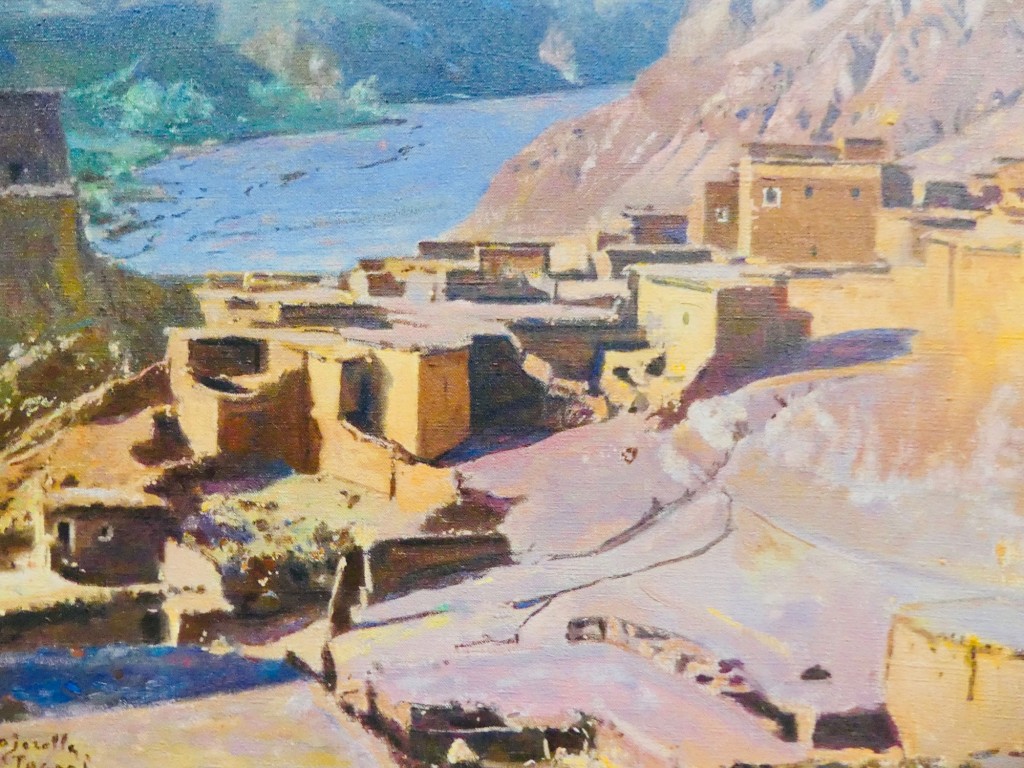
Village de Tasgah, vallée de Telouet – Jacques Majorelle
Blue always remains very strong in Jacques Majorelle painting, electric or intense.
Particularly on his landscape paintings below:
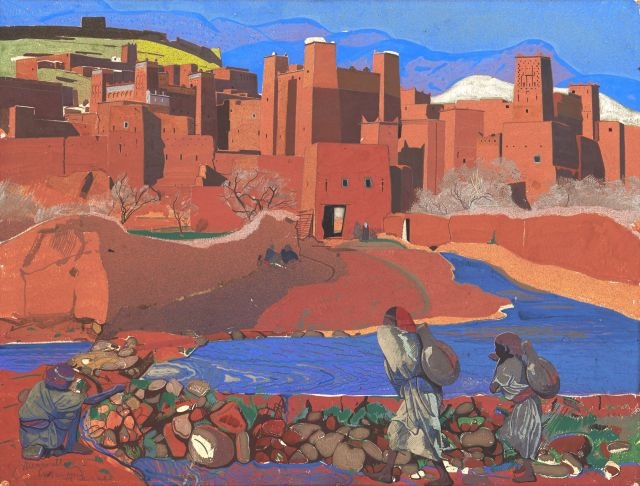
Aït Ben Addou, Vallée de L’oued Mellah, Grand Atlas, La Séguia – Jacques Majorelle
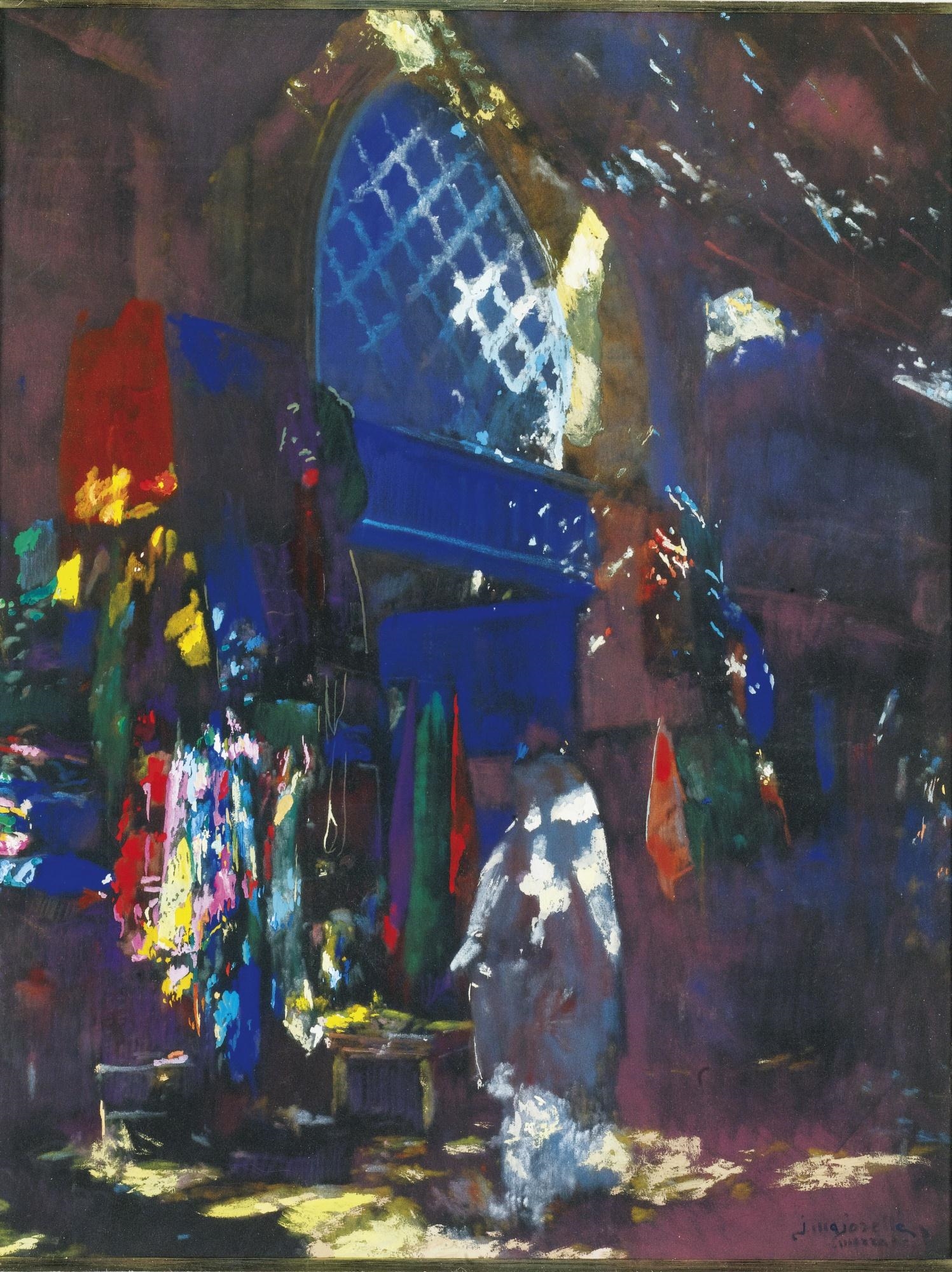
Jacques majorelle_A market in Marrakech
But also in his scenes of African Nudes:
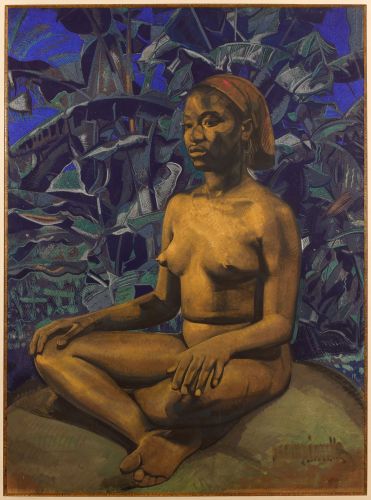
Jacques-Majorelle Fatima Marrakech, circa 1934
Discover the life and work of Jacques Majorelle
Jacques Majorelle will apply this Blue a bit everywhere in the park of the villa workshop, on the portals, pergolas and jars of the eponymous garden. This ultramarine cobalt blue, which creates such a cheerful and relaxing atmosphere, will become the famous Majorelle Blue. Today registered name, this color is composed of 37.6% red, 31.4% green and 86.3% blue, it is saturated at 64% and clear at 86%.
This blue alone characterizes the Majorelle Garden in Marrakech with its irregular paths, which does not obey any rules in terms of organization or style, but remains simply the work of a painter and architect.
3/ The Majorelle Garden… a Voracious Ogre
For 40 years, Jacques Majorelle, the Painter Gardener, worked laboriously in his garden to turn it into “a cathedral of forms and colours”, “an impressionist garden”.
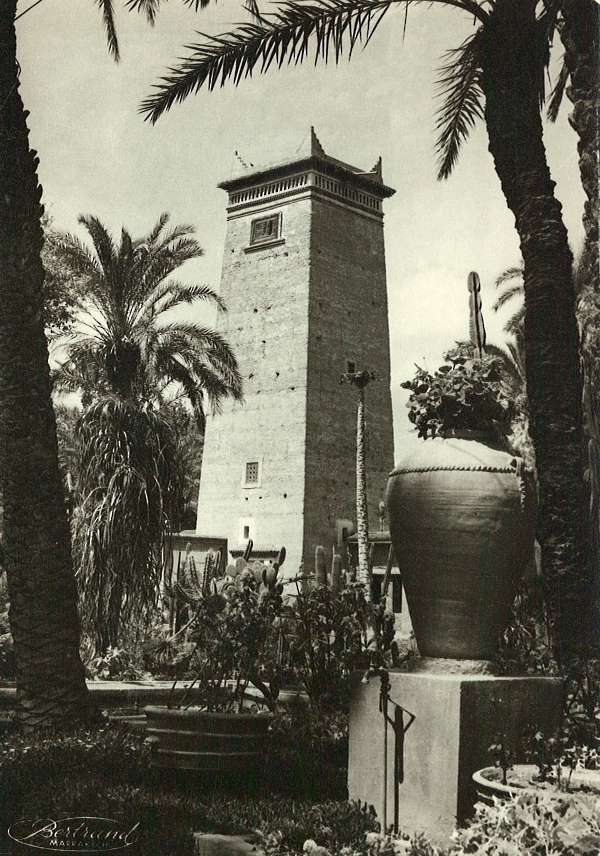
Borj-Jardin-Majorelle-1924
During his travels, he brings back plants from all over the world or exchanges with correspondents like him passionate about botany, hundreds of plants : bamboos, cacti, coconut trees, willows, palm trees, thuyas, jasmines, water lilies, agaves, carob trees, bougainvilleas, daturas, cypress trees, ferns…,
Jacques Majorelle said: “The painter has the modesty to hold this pen of green flowers for his most beautiful work”. He speaks of it as “the vast splendours whose harmony I orchestrate (…) This garden is a terrible task, to which I give myself entirely. He will take my last years and I will fall exhausted, under his branches after having given him all my love.
Winston Churchill, usual traveler in Marrakech, regularly comes to the Majorelle garden.
In 1947, Majorelle Garden in Marrakech was also a “voracious ogre garden”, with expensive maintenance, and became so expensive that it had to be open to the public and apply an entrance fee to visitors.
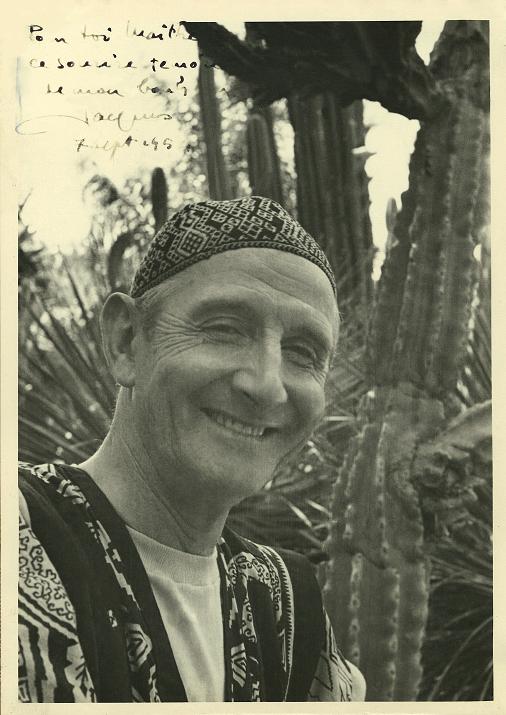
Jacques Majorelle artist gardener in Marrakech
In 1956, following a long period of conflict with his wife Andrée Longueville and his divorce a few years later, Jacques Majorelle was forced to divide his property. His ex-wife recovers a large part of the property and notably half of the garden as well as one of the houses: The villa Bou Saf Saf on 1 hectare, which is then separated from the rest of the property.
A serious car accident in 1955 caused him to lose his left leg and compromise his financial situation. He is forced to give up his share of the Majorelle Garden in Marrakech and the villa workshop. In 1962, a second car accident was fatal. He is buried in Nancy, France. The garden, left abandoned, then falls into decay.
4/ Marrakech shock… A few Years later
In February 1966, the French Couturier Yves Saint Laurent and his friend Pierre Berger arrived in Marrakech aboard an Air France caravel. They stayed in La Mamounia, at the time an outdated luxury hotel. The weather is gloomy, they don’t really like the city. Then the sun appears, the atlas unveils its snowy peaks, the scents of jasmine embalm the air and the sun floods the city with light. It’s a shock.
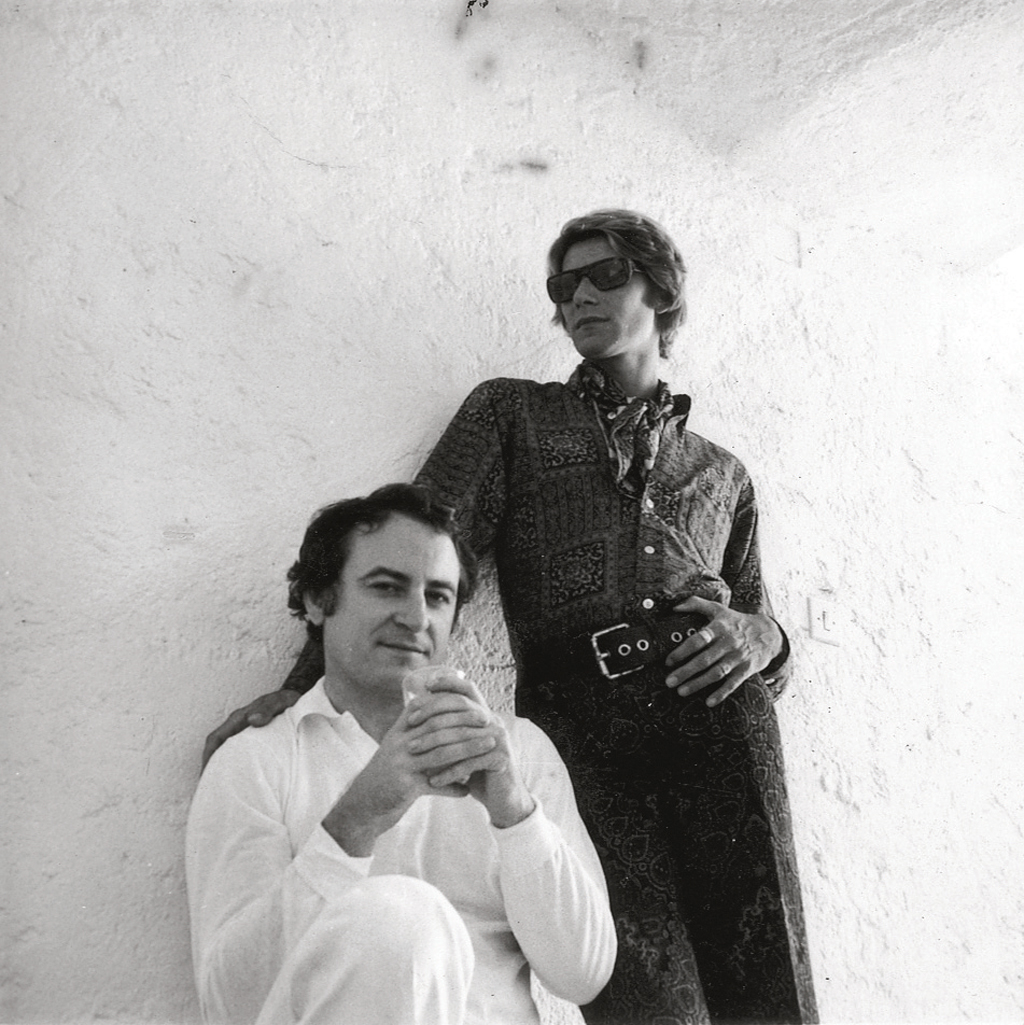
Pierre-Berge-et-Yves-Saint-Laurent-Marrakech ©DR
Pierre Bergé writes in “une passion marocaine”, his book hommage at YSL: “When Yves Saint Laurent discovered Marrakech in 1966, it was such a shock that he immediately decided to buy a Moroccan house and come back regularly”. They actually left with the act of buying Dar Al Hanch (“the house of the snake” in Arabic), in the medina, near Bab Doukkala.
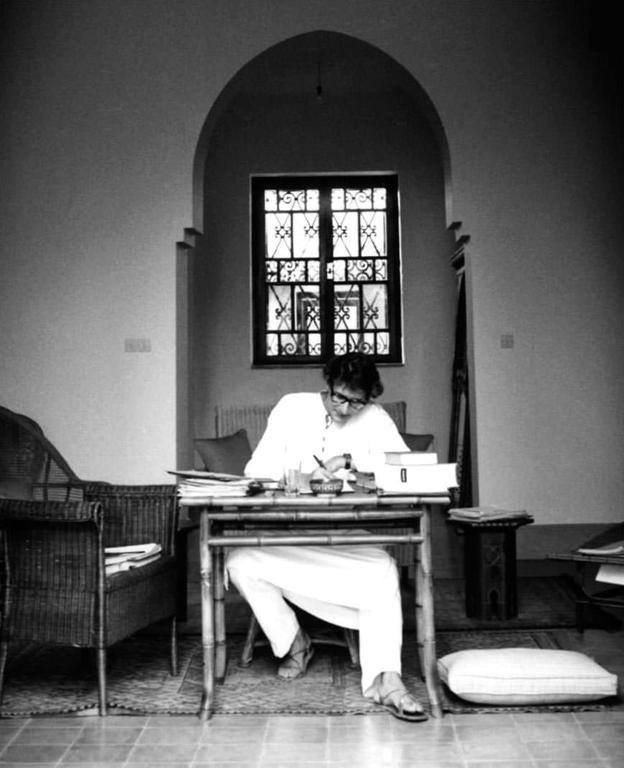
Dar-el Hanch, la maison au serpent, résidence a Marrakech de Pierre Bergé et Yves Saint Laurent en 1966
5/ Moroccan Colours and the Majorelle Oasis
YSL and Pierre Bergé frequent the Majorelle Garden in Marrakech from their first visit in 1966and fall in love with it.” We were seduced by this oasis where the colours of Matisse mix with those of nature (…) Very quickly we became familiar with this garden, there were hardly any days without us going there. It was open to the public but there was almost no one.”
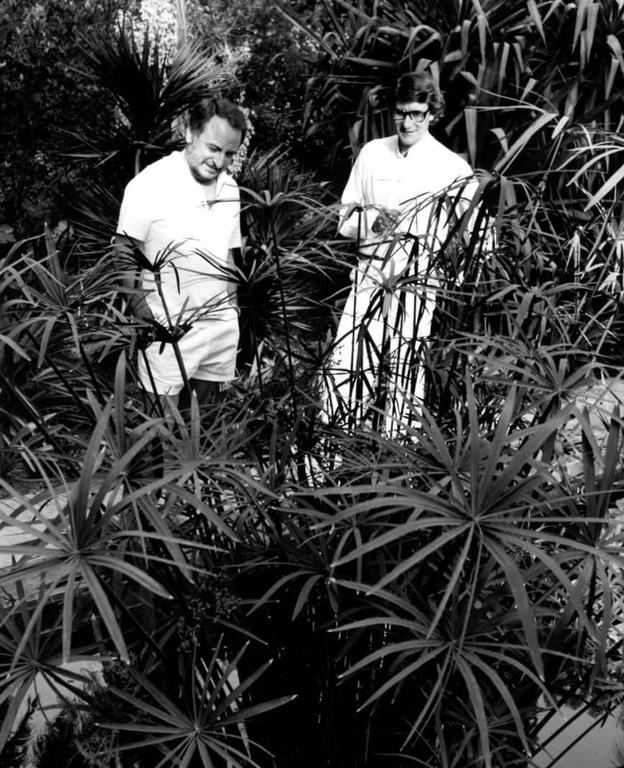
Pierre-Berge-Yves-Saint-Laurent jardin majorelle marrakech
Yves Saint Laurent said “for many years, I have found in the Majorelle Garden in Marrakech an inexhaustible source of inspiration and I have often dreamt of its unique colours”.
YSL: “In Morocco, I understood that my own chromatism was that of zelliges, zouacs, djellabas and caftans. The audacities that have been mine since, I owe them to this country, the violence of the agreements, the insolence of the mixtures, the ardour of the inventions.”
Morocco was in fact a major aesthetic shock for the creator, echoing Algeria where he was born in 1936 and lived until the age of 17 in Oran. It was the same Africa he rediscovered 30 years later. Solar earth flooded with light, Marrakech is an explosion of colors. Pitted by orientalism, the couturier considers that he has tamed colour. He will return to Marrakech twice a year, in December and June, to design his haute couture collections. The light of Morocco reveals the color to him.” It was then that I became more sensitive to light and colours, that I noticed especially the light on colours […]”.
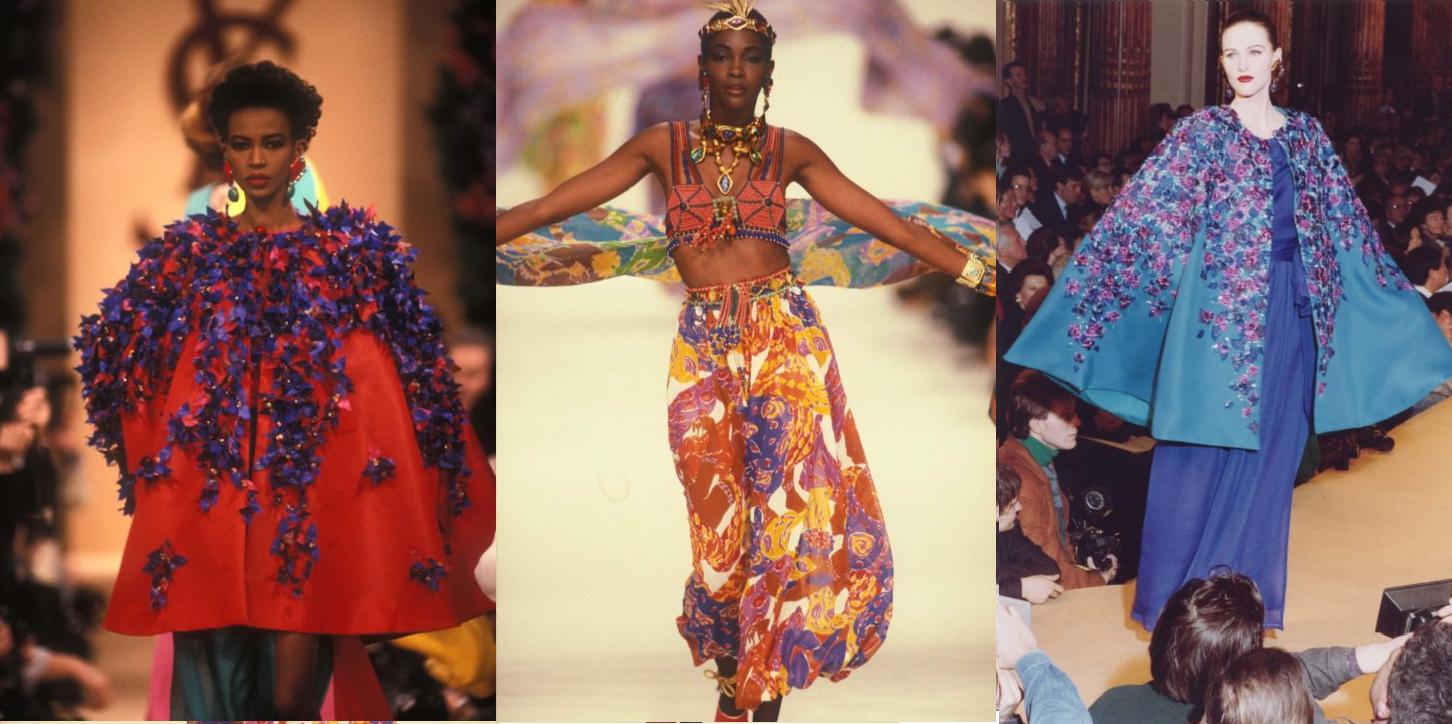
Yves saint laurent Défilé Haute Couture ©Guy-Marineau
In 1974, the couple sold Dar el Hanch to a friend, and bought the villa Dar Es Saada, “the house of happiness”, with garden and swimming pool, in Guéliz, in the immediate vicinity of the Majorelle Garden.
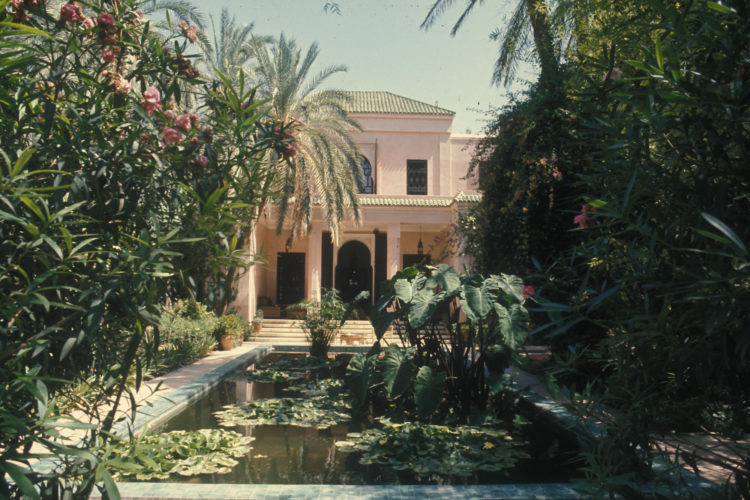
YSL_Marrakech_Dar Es Saada 1977 ©Guy-Marineau
6/ The Purchase of the Villa Oasis and the Majorelle Garden in Marrakech
The Majorelle Garden in Marrakech is abandoned and falls into disuse. A hotel complex project threatens to destroy it.” We can’t let that happen,” exclaims Pierre Bergé, who is doing everything possible to stop the project.
In 1980, YSL and himself managed to buy the Majorelle garden and the adjoining Moorish villa, named Bou Saf Saf by Jacques Majorelle, after the name of the locality, and which they renamed Villa Oasis. They decide to live in the painter’s villa which they renovate with the help of their friend the decorator Bill Willis.
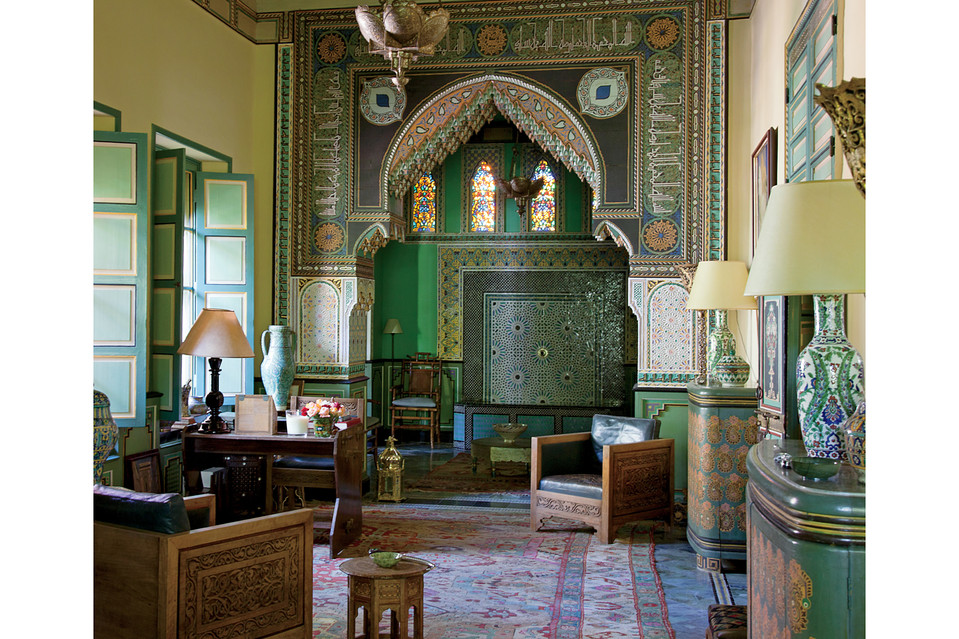
salon villa marrakech oasis ysl bou saf saf
The garden with the blue cubist villa, which now extends over only half a hectare, is the object of a safeguard to”…make the Majorelle garden the most beautiful garden – the one Jacques Majorelle had thought of, envisaged”.
In the 1980’s, a museum of Islamic Art was created within the walls of the Cubist villa. It presents pieces from PB and YSL’s personal collection. The art objects come from the East, Africa and Asia.
In 1998 the owners approached Abderrazak Benchaabane, an ethnobotanist from Marrakech, to make an inventory of the species and provide their Latin name. After having categorized 120 varieties, the botanist proceeds to the restoration of the site. Abderrazzak Benchaabane spends 10 years bringing the garden back to life. He had carte blanche to add new varieties to the plant families chosen by Majorelle. An automatic irrigation system was installed and the flora increased from 135 species in 1999 to 325. There are agaces, aloe vera and lotus among others. 20 workers work daily.
YSL enhanced the Majorelle Blue colour, to make it more invigorating. He also added touches of bright yellow and jade green, with the help of his friend Jacques Grange.
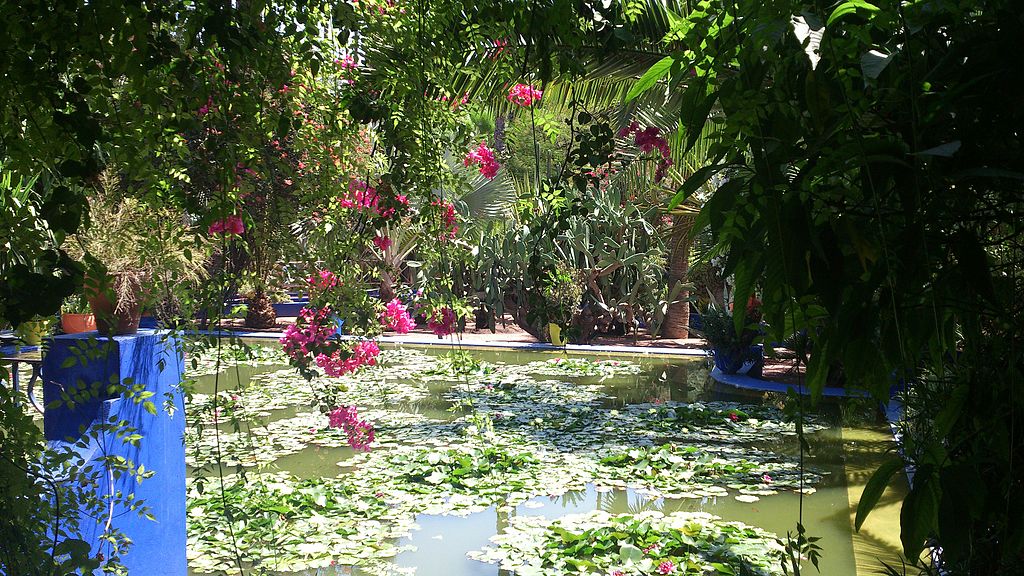
Blue,_green_and_pink nenuphar in majorelle garden in marrakech
The fauna of the Garden is also a real spectacle in itself. The songs of garden bulbuls, blackbirds, robins, warblers, turtle doves, titmice, grey wagtails or house sparrows echo. On the ground, the water turtles and frogs that croak at the end of the day entertain visitors.
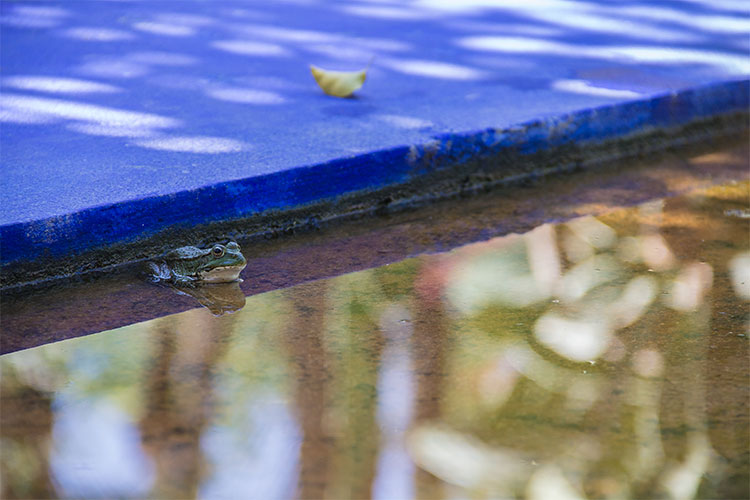
grenouille du jardin majorelle marrakech
7/ The Majorelle Garden Foundation
In 2001, YSL and Pierre Bergé decided to create the Association Jardin Majorelle with the aim of safeguarding the ecological, historical and cultural heritage represented by the Jardin Majorelle.
On January 7, 2002, Yves Saint Laurent’s fashion house closed its doors with the end of the couturier’s career. The association Jardin Majorelle thus extends 40 years of the Yves Saint Laurent Haute Couture brand.
On 1 June 2008, Yves Saint Laurent passed away at the age of 71 in his Parisian home, 55 rue de Babylone. His ashes were spread in the rose garden of the Garden of the Villa Oasis. A memorial in the shape of a Roman Column, brought back from Tangier, and which bears a plaque with its name, symbolizes the presence of YSL in the garden.
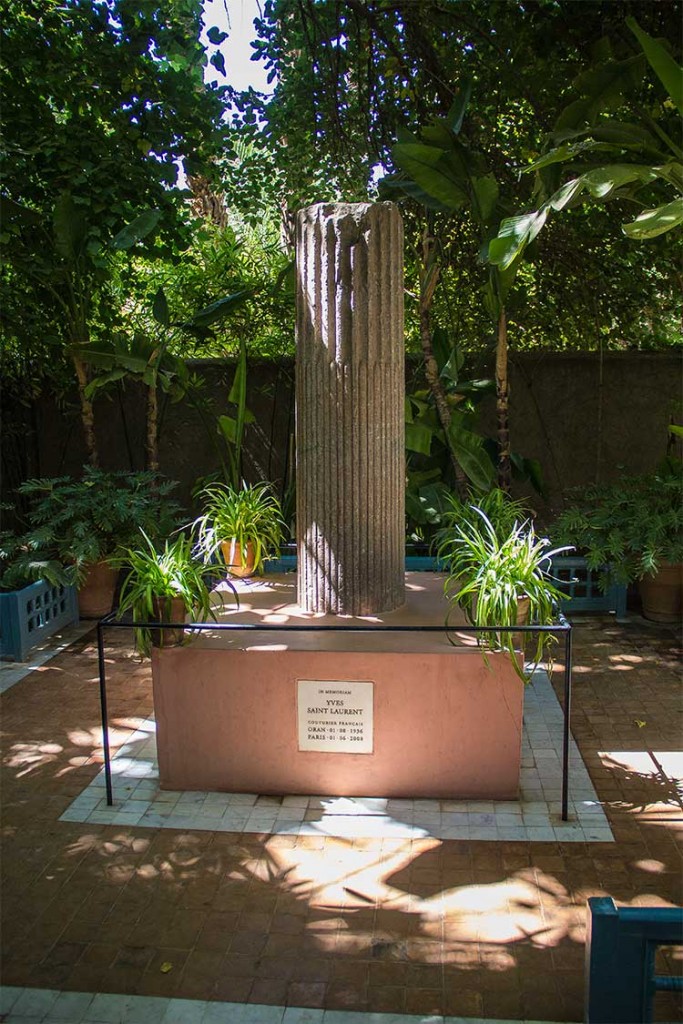
colonne memorial-yves-saint-laurent-jardin-majorelle-marrakech
In 2010, HRH Princess Lalla Salma, wife of King Mohamed 6 of Morocco, inaugurates the Rue Yves Saint Laurent, which is located in front of the entrance to the Majorelle garden, as well as the Yves Saint Laurent and Morocco exhibition.
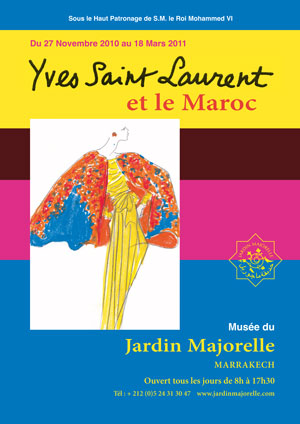
Affiche yves saint laurent et le Maroc – jardin majorelle 2010
In 2011, a decree recognized the Association Jardin Majorelle of public utility, which became the “Fondation Jardin Majorelle“, owned by PB and YSL. The foundation supports numerous cultural, educational and medical projects. To date, the Fondation Jardin Majorelle has been transferred to the assets of the French foundation PB – YSL.
8/ The Berber Museum of the Majorelle Garden
The same year, the Cubist workshop created by Paul Sinoir houses in its basement the Berber Museum, which replaces the Museum of Islamic Art. It is inaugurated under the high patronage of HRH King Mohamed of Morocco 6 on December 3, 2011 in the presence of the French Minister of Culture. The Imazighen, or Berbers, are one of the oldest populations of the Maghreb. They still represent 40% of the current Moroccan population. In his speech of December 9, 2011, SAR Mohamed 6 evoked “the Berber, the common heritage of all Moroccans”.
Pierre Bergé and Yves Saint Laurent are personally interested in Berber culture. More than 600 objects from the YSL-PB collection are on display at the Berber Museum.
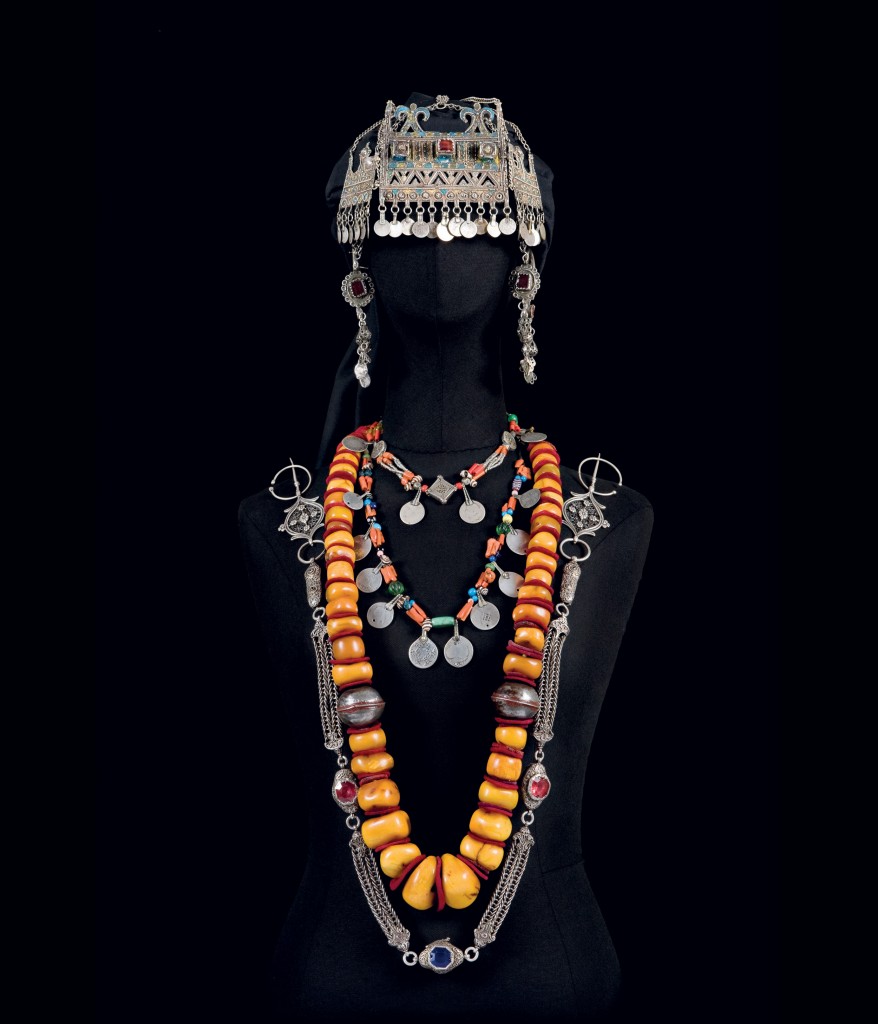
Parures-Ait-Ouaouzguite-©-Musée-Berbère- Majorelle_photo-Nicolas-Mathéus
The same day, the villa Oasis, ex villa Bou Saf Saf of Jacques Majorelle, is classified “house of the Illustrious“. This French label highlights the remarkable houses by their history and that of these inhabitants. It is the 1st villa classified out of France.
In 2016, His Majesty King Mohammed VI of Morocco awarded Pierre Bergé the distinction of Grand Cross of the Order of Ouissam Alaouite for his contribution to the Kingdom of Morocco.
Pierre Bergé died on 08 September 2017 at his home in Saint Rémy de Provence, France, a few months before the inauguration of the Yves Saint Laurent Museum in Marrakech and Paris. Madison Cox is now home to the Majorelle Garden and the Yves Saint Laurent Museum, the new president of the Pierre Bergé – Yves Saint Laurent Foundation.
Open every day of the year, the Jardin Majorelle employs 90 people. Its profits support other projects in Morocco.
As Pierre Bergé wished… “Thus continues this adventure begun in 1962 when we did not know that destiny was going to make us sign» (1962: launch of the ysl haute couture house)
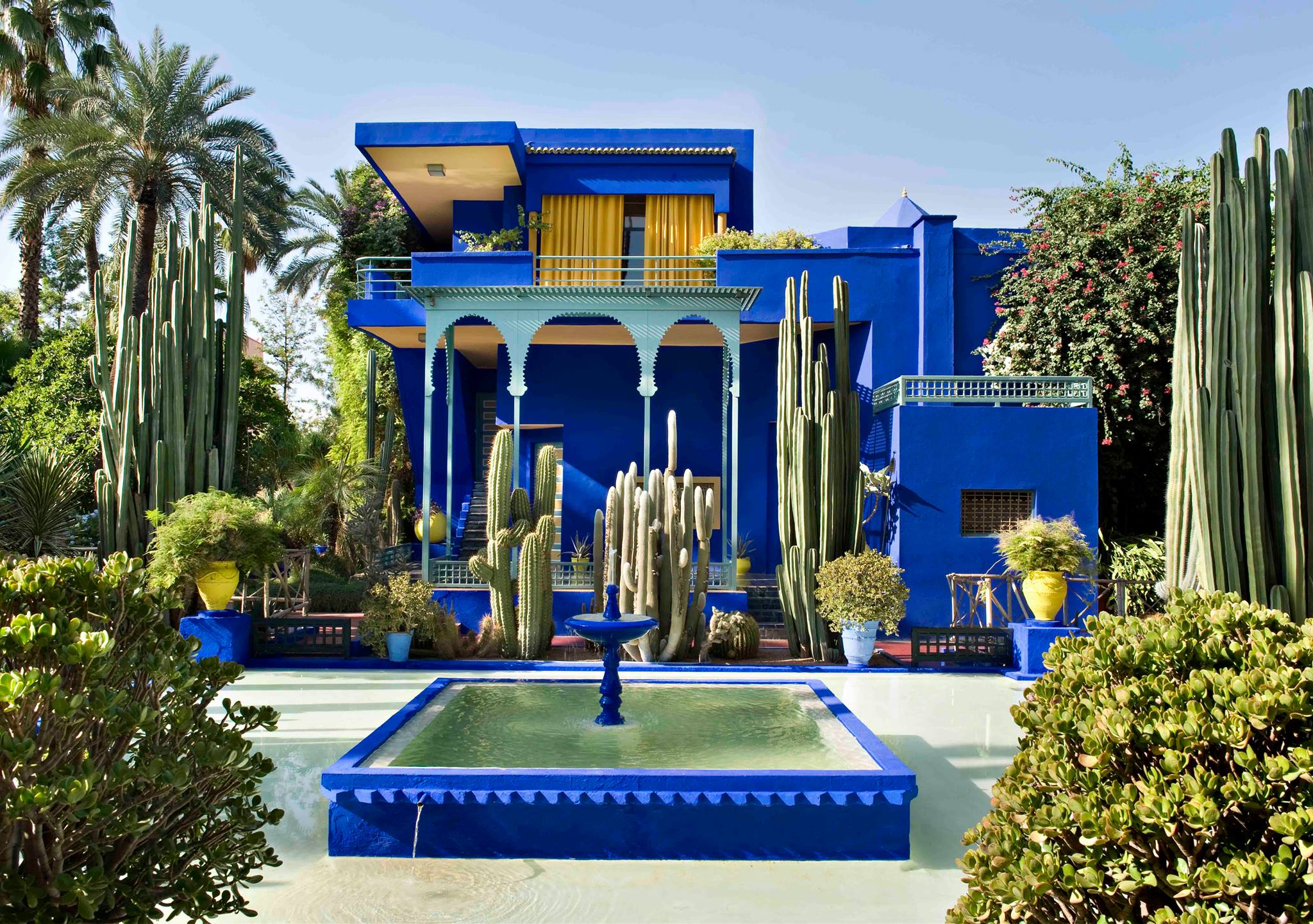
Atelier Villa Cubiste Bleue Jardin Majorelle – Architecte Paul Sinoir
9/ The Love Gallery of Majorelle Garden in Marrakech: A History of Love
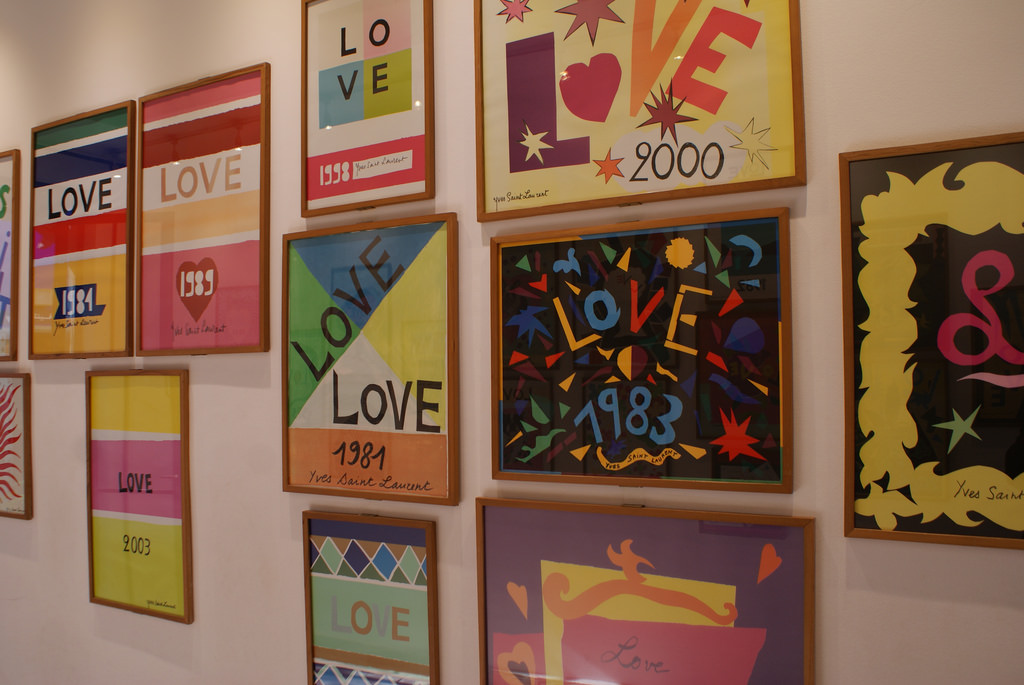
jardin majorelle affiches galerie love yves saint laurent
The Gallery LOVE of Jardin Majorelle, which gathers the colorful greeting cards that Yves Saint Laurent designed and addressed to his Clients, represents all the love that Saint Laurent and Bergé gave and received from Majorelle, the garden of the adventurer painter, who almost perished en 1980.
Practical Info :
Jardin Majorelle Rue Yves Saint Laurent Marrakech, Morocco +212 (0)5 24 31 30 47 – Email : info@jardinmajorelle.com – www.jardinmajorelle.com
Public rate Garden only : 70 Dhs – Museum supplement : 30 Dhs
Possibility of Combined Ticket mYSLm Yves Saint Laurent Museum + Majorelle Garden – Warning: mYSLm closed WEDNESDAY
Moroccans and foreign residents in Morocco Garden only: 40 DhsMuseum : 10 Dhs
Children under 12 : Free of charge
Majorelle garden open every day of the year
October 1st to April 30th: 8am to 5 :30pm – May 1st to September 30th: 8am to 6pm
Ramadan Month: 9am to 5pm
